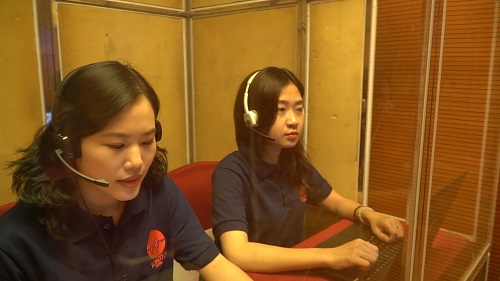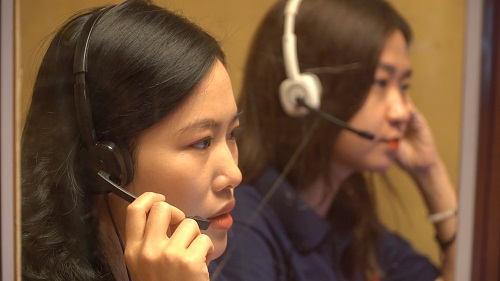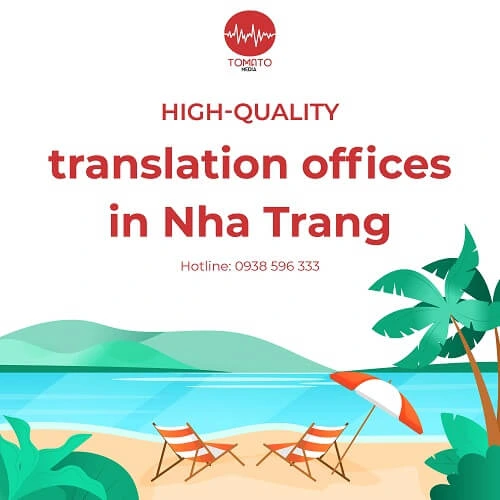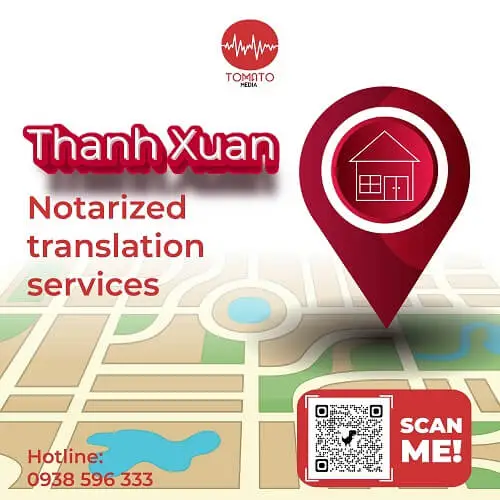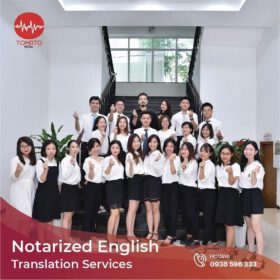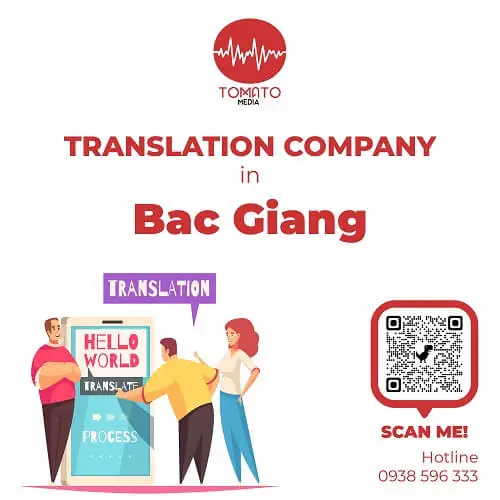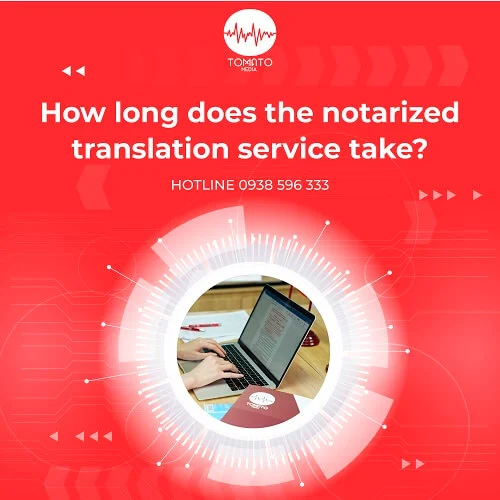Do you need to find a translation company in Nha Trang? Or are you looking for an interpreter to help perform the translation task at projects or meetings with customers in Nha Trang? But have you not found a reputable translation unit yet? Let us help you decide through the article below. What criteria help [...]
Simultaneous interpretation and things you should know
Simultaneous interpretation is considered difficult for professionals in the translation industry. Therefore, understanding the details of this activity can help the interpreter, as well as the customer, make thorough preparations before selection and implementation. Let’s join us in learning this type of translation in the article below.
Register for simultaneous interpretation services

NỘI DUNG (CONTENT)
What is simultaneous interpretation?
How can simultaneous interpretation be implemented? Simultaneous interpretation is a form of interpretation where an interpreter translates the message from the source language to the target language in real-time without the use of a translation machine. This type of interpretation is often used in high-level conferences, seminars, and large-scale international projects.
Simultaneous/Cabin interpretation is a type of interpretation where the interpreter sits in a soundproof booth. They use headphones to listen to the speaker’s speech in the source language and immediately translate it into the target language via a microphone. The information is then transmitted to the listener’s headphones.
The standard speed requirement for a simultaneous interpreter is 0.3 to 0.4 seconds and 3.4 seconds at the latest after the speaker finishes his or her sentence. Therefore, it is undeniable to say that simultaneous interpretation is the “pinnacle” of the interpretation profession.
Advantages and disadvantages of simultaneous interpretation
The interpreter won’t need much time to finish the job because of the nature of simultaneous interpretation. Therefore, seminars, conferences, or events can be completed twice as quickly as using conventional interpreters, which saves time for the parties to organize and participate in the event.
Furthermore, the simultaneous interpretation helps to obtain proceedings after the interpretation ends. Usually, the entire audio system, including the microphone, is connected to the recording device. Once the event is over, the records are completely available to the parties for use in drafting the proceedings.
On the contrary, pricing is the biggest drawback when choosing this form of translation. Simultaneous interpretation requires experienced, skilled, and calm professionals to handle situations that arise and, above all, possess the fundamental knowledge of the field in which they translate. This will result in very high service costs, depending on the specialization and the language to be translated.
The form of simultaneous interpretation is applied to many professions, topics
The simultaneous interpretation service can be applied to various fields. Some key areas are often chosen by customers, such as:
| Economy | Media – Entertainment | Medical – Pharmaceutical | |||
| Information technology | Banking and finance | Education | |||
| Environment | Oil and gas | Marketing | |||
| Tourism | Construction | Engineering – Manufacturing | |||
|
Automotive engineering |
Legal |
Life sciences |
|||
| Ecommerce |
Electricity – Electronics |
➩ | … |
Essential abilities for a simultaneous interpreter
Becoming a capable interpreter for simultaneous interpretation is not as simple as other types of translation. A simultaneous interpreter has to fulfill the following requirements in order to complete a simultaneous interpretation session:
- A high level of expertise, knowledge of at least two target languages, a large vocabulary, and familiarity with the cultures and lifestyles of target language countries are all requirements for translators.
- The excellent ability to hear, understand, analyze, and translate information quickly, accurately, and fully
- Agility and the ability to work under pressure are needed to keep up with the speaker’s speed during the simultaneous interpretation session. In addition, a simultaneous interpreter needs to refrain from expressing personal feelings so as not to affect the quality of work.
- Careful, thoughtful, professional working attitude, paying special attention to the accuracy of information.
- Flexibility, good health, and willingness to go on business trips.
- Good teamwork is needed to actively support members.
- The ability to predict the full meaning of the speaker’s sentence even if they have not finished it.
- Some other requirements when implementing simultaneous interpretation include:
- Have the ability to listen to and communicate information clearly
- Use sentence structures fluently
- Absolute objectivity with translated content.
Maybe you’re interested in:
- What is consecutive interpreting? Events that should use consecutive interpreting
- Learn more about interpreting: concepts, levels, and common types of interpreting.
How much does the simultaneous interpretation service cost?
You can easily refer to the simultaneous interpretation price list on the website of any translation company. However, most of them are for reference only. An accurate quotation for an interpretation service depends on different factors
- The popularity of translation languages: simultaneous interpretation in English, Chinese, Japanese, Korean, etc. can cost less than rare languages with only a few capable interpreters such as Dutch, Danish, Norwegian, Arabic, etc. With such difficult languages, experts must invest time in research to ensure the highest quality and most effective interpretation session.
- Interpreter’s experience: For events that do not require highly specialized interpreters such as simple business exchanges, weddings, and real estate lease signing, the interpretation service cost can be different from specialized activities such as seminars, high-level conferences, tech events, live TV shows, etc.
- Interpretation duration: If a project has a long interpreting duration (8 hours or more), the interpretation cost can be higher than that of shorter sessions that only take place for a few hours.
- The number of interpreters: For extended interpretation sessions, 2 or more interpreters can be required. Using only one interpreter can have some negative effects on the quality and accuracy of the interpretation when the interpreter must translate for a long period of time because this type of interpretation is extremely difficult and requires intense concentration.
- The field to be translated: with a complex area of specialization that only a few interpreters are knowledgeable about, the price may be higher.
To have a successful simultaneous interpretation in English, Chinese, Japanese, Korean, and many other languages, what should be guaranteed?
In order to help the simultaneous interpretation process for conferences, seminars, and other large-scale events go well, you need to note the following points:
- Select a reputable simultaneous interpretation service provider that has a quality interpreter team
- Prepare high-quality translation equipment for interpreters and guests.
- Have a professional support team to solve the situations that arise.
For interpreters, the level of expertise can be accumulated and forged through interpreting experiences. We would like to summarize the experience of interpreters who have engaged in the profession for years:
1| Constantly learn and cultivate new knowledge
Simultaneous interpreters need to constantly learn and develop their skills and knowledge. If interpreters stop updating their knowledge, terminology, and expertise, it is difficult for them to meet the changing interpretation needs over time.
2| Predict the message the speaker will convey
For longtime practitioners, they can anticipate the meaning of the information that speakers want to convey. Since the requirements of the simultaneous interpreter are speed and the right message, the interpreters need to judge the speaker’s message by the sentence structure or the first words.
3| Thorough preparation before the interpretation session
Preparation for any activity plays an important role in the successful outcome of that event, including interpretation. Therefore, interpreters have to ensure that they have sufficient time to get ready. In particular, for specialized and large-scale seminars, it is essential to learn the terms in advance. This helps them have a professional working style and a fluent expression of accurate information from speakers.
Also, it’s necessary to check if the translation equipment works properly or not. A small technical error can also affect the quality of the interpretation session.
4| An intense schedule with too many projects is not recommended.
The translation industry in general and simultaneous interpretation in particular require high concentration and thorough preparation before implementation. If an interpreter sets a tight schedule, it will be difficult to guarantee the quality of the translation. As a result, in the eyes of customers and partners, a reputable and professional company can own a team of interpreters to manage and arrange reasonable schedules for interpretation projects.
What equipment is required for an English simultaneous interpretation session?
When used in large national or multinational events, the equipment used for simultaneous English, Chinese, and other language interpretation has to meet stringent functionality and modern quality standards. In particular, the instruments are required to produce clear sound, a strong signal, and stable transmission.
Equipment for an interpretation session includes:
- Booth system: a soundproof booth for two people, a translation mixer, a signal light, and a power cord.
- Multilingual translation system: headset, signal wire, signal splitter.
- Audio: speaker; wireless microphone; desktop microphone; signal cable.
Please note that the translation device has a principle of operation based on its ability to transmit wireless signals from the microphone to the listener. This helps to limit interference that affects work activities. As a result, the device can only assist interpreters in transmitting information to the listener; there is no automatic translation function.
Is simultaneous interpretation really as difficult as rumors say?
Why is simultaneous interpretation described as a profession for masters? An interpreter capable of simultaneous interpretation is not only fluent in the language, but also knowledgeable about the culture and people of the country where that language is spoken, as well as having good health and exceptional agility. In particular, the interpreter must have an easy-to-hear, pleasant voice. As a result, they must communicate information with the speaker simultaneously; and the translation must keep up with the speech and be error-free.
Therefore, this is a very demanding profession in addition to having an attractive salary. Only those who are passionate, persistent, and forward-thinking are capable of achieving worthy results.
Simultaneous interpretation – the culmination of the interpretation profession – can be said to be a field that offers countless opportunities but also many challenges. If you are looking for a reputable, quality interpreter, you can contact Tomato Media for consultation and support.
Frequently asked questions about simultaneous interpreting and translation services
Here are some frequently asked questions about simultaneous interpreting and translation services collected by us:
Why is simultaneous interpreting commonly used?
This form of interpreting helps save time because the translation takes place almost simultaneously with the speaker. Therefore, this form of interpreting is popular, especially during large meetings and long conversational periods.
In what situations is simultaneous interpreting often used?
In large-scale conferences and seminars, there are many attendees, a variety of content, and a long meeting duration.
Should a simultaneous interpreter be hired?
Simultaneous interpreting requires a lot of language and translation skills. Therefore, if your company does not have available resources that meet the above criteria, you should hire a simultaneous interpreter. Professional interpreters, with the help of modern equipment, can help the translation session go smoothly.
How long does a simultaneous interpreter usually take to prepare for the interpreting session?
For small events with simple content, it can take an interpreter 1-2 days to prepare and learn about the field to be translated. However, with larger events, the interpreter needs to spend a whole week or even more time.
Does the simultaneous interpreting profession have a high income?
The level of income of the simultaneous interpreting profession is always in the high-income group due to the specifics of the work. Today, the income of a skilled translator is between USD 250-500 a day.
What are the job opportunities in simultaneous interpreting?
In recent years, the demand for translation services has increased sharply thanks to increased international exchange and cooperation. Interpreters can work at conferences, seminars, professional training, conversations, product presentations, press conferences, etc.
Hopefully, the above article can help you learn more about what simultaneous interpretation is.



